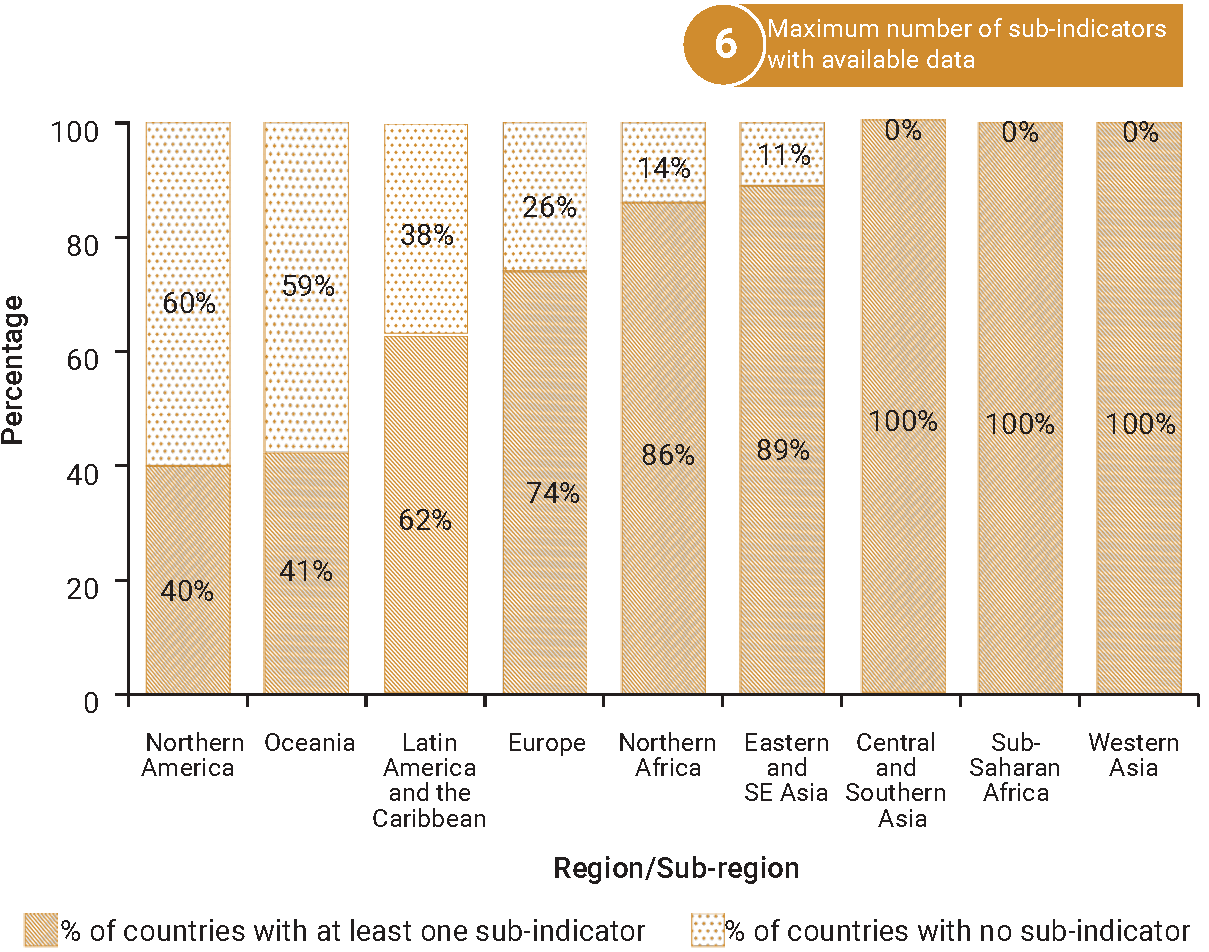SDG Indicator 6.5.1: Degree of integrated water resources management
1. Key features and metadata
Definition: This indicator monitors the degree of implementation of integrated water resources management (IWRM), on a scale of 0-100, by assessing four key dimensions: the enabling environment, institutions and participation, management instruments and financing.
| Sub-indicator | Disaggregated by |
|---|---|
|
ER_H2O_IWRMP Proportion of countries by IWRM implementation category (%) |
Level of implementation |
|
ER_H2O_IWRMD Degree of integrated water resources management implementation (%) |
No current data disaggregation available.
|
|
ER_H2O_IWRMD_EE Degree of integrated water resources management implementation, enabling environment (%) |
|
|
ER_H2O_IWRMD_IP Degree of integrated water resources management implementation, institutions and participation (%) |
|
|
ER_H2O_IWRMD_MI Degree of integrated water resources management implementation, management instruments (%) |
|
|
ER_H2O_IWRMD_FI Degree of integrated water resources management implementation, financing (%) |
Sources of information: Data is collected through a self-assessed country survey, with 33 questions scored on a scale of 0-100. Responses are consolidated through consultations between relevant stakeholders (national and sub-national line ministries, institutions involved in water resources management and other stakeholders such as NGOs, academia and business).
Related SDG Indicators: All other SDG 6 indicators and more specifically 6.5.2 (Proportion of transboundary basin area with an operational arrangement for water cooperation) and 17.14.1 (Number of countries with mechanisms in place to enhance policy coherence of sustainable development).
2. Data availability by region, SDG Global Database, as of 02 July 2025

3. Proposed disaggregation, links to policymaking and its impact
| Proposed disaggregation | Link to policymaking | Impact |
|---|---|---|
|
Degree of integrated water resources management: coordination between national government authorities, representing different sectors, on water resources policy, planning and management (%)(UNEP 2021b; UNEP and Global Water Partnership [GWP] 2023a; UNEP and GWP 2023b): This uses question 2.1b from the SDG 6.5.1 survey, scored on a scale of 0-100. |
The aim of this disaggregation is to track whether IWRM is implemented through clear and articulated coordination processes. It helps identify the gaps in coordination mechanisms in place for adopting the remedial measures to ensure better consistency in all water-related activities as needed. It also promotes policy coherence for sustainable development.Cross-institutional and cross-sectoral coordination of water management interventions, at national, basin and aquifer levels, is essential for ensuring sustainable and efficient water management(UNEP 2021b). It is imperative that authorities at various levels are designated IWRM implementation, with a clear legal mandate, resources (i.e. human, administrative and financial) and responsibilities (i.e. coordination of water- related institutions and stakeholders, planning and investment programs, consultation, and water policy monitoring and evaluation)(UNEP and GWP 2023b; UNEP et al. n.d.). It contributes to the UN Water Action Decade(UNGA 2017b)and the SDG 6 Global Acceleration Framework(UN-Water 2020). |
IWRM is a policy tool with the objective of balancing competing water demands across sectors, including ecological needs (Eflows). Addressing the increasing and competing demands on water resources as well as their adverse impacts (e.g. water stress, increasing water variability or water quality degradation) – compounded by climate change – requires the deployment of formal coordination mechanisms on all aspects of water management (i.e. regulatory and institutional frameworks, investment planning and water finance) to ensure sustainable development and climate resilience(UNEP 2024a). Coordination across the water sector and with other sectors is required to ensure accessibility for all water users and enhanced water mainstreaming into other sector interventions (e.g. food production, poverty reduction strategies or climate change policies), to generate greater synergies, to prevent conflicting actions and wasteful allocation, and to foster effective and efficient water management(UNEP 2021b; UN, 2022). |
|
Degree of participation in water resources management (%)(UNEP 2021b; UNEP and GWP 2023a; UNEP and GWP 2023b): These are measured through responses from the 6.5.1 survey, on a scale of 0-100.
|
This disaggregation tracks whether IWRM is implemented through broad stakeholder participation processes, involving all categories of water users (i.e. water user associations, indigenous groups and communities, the private sector, academia or media) and with particular consideration of women and vulnerable groups(UNEP and GWP 2023b; UNEP et al. n.d.). This disaggregation is useful to decision-makers in highlighting the contribution of participation to the overall effectiveness of IWRM and to show where progress can be made to promote consultation, collaboration, representation and co-decision-making in this area. It contributes to the UN Water Action Decade(UNGA 2017b)and the SDG 6 Global Acceleration Framework(UN-Water 2020). |
The development of inclusive participatory processes is essential to ensure the equitable, effective and sustainable allocation of water resources based on the use of the best context-specific information available. Well-organized stakeholder engagement leads to better results in water management planning and is a requisite for the better mainstreaming of water-related aspirations and needs for vulnerable groups and women.IWRM implementation is an opportunity to better inform vulnerable and under-represented groups and foster their participation in water resources management decisions and activities. This is achievable by establishing dedicated organizations that can represent their concerns in river basin committees when river basin authorities have been established or in water user committees(UNEP 2021b; UN 2022a). |

